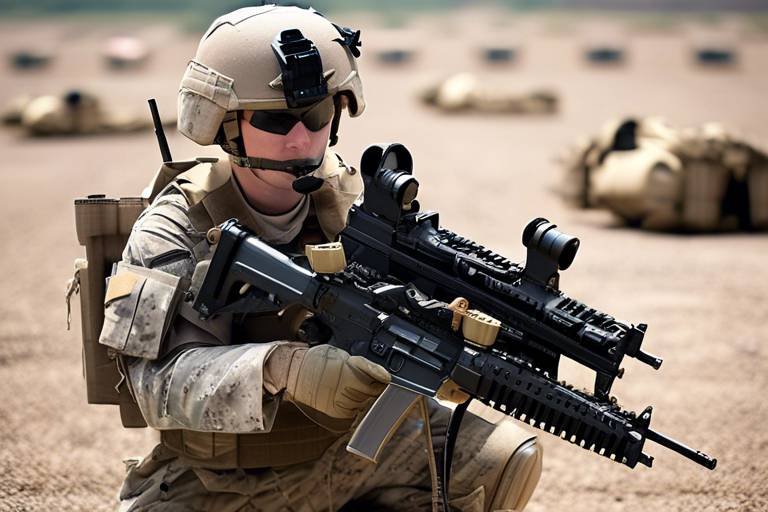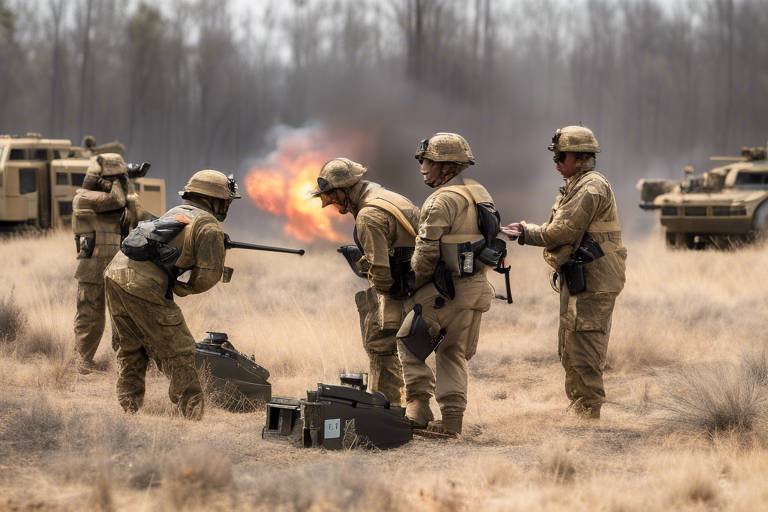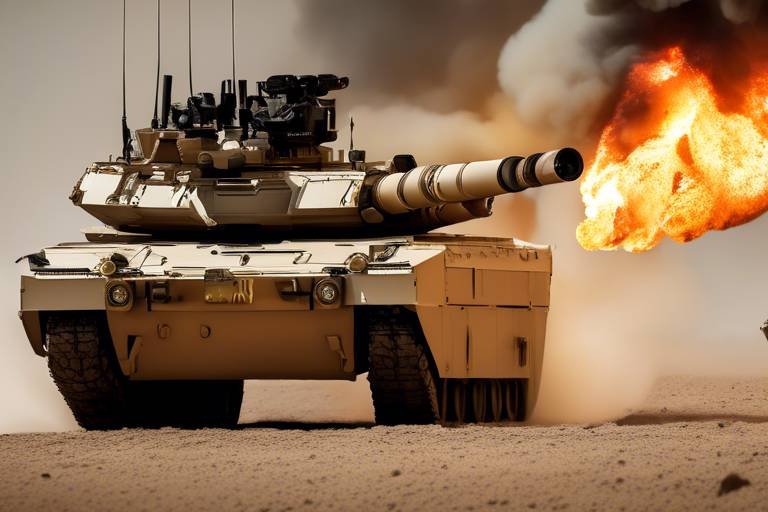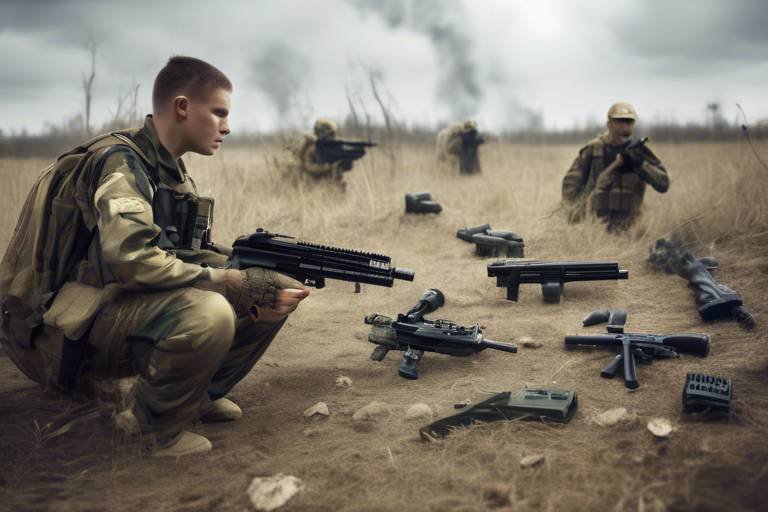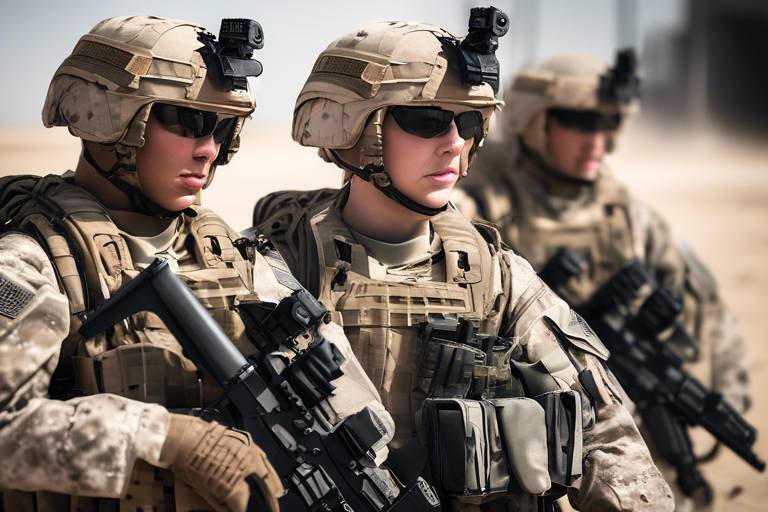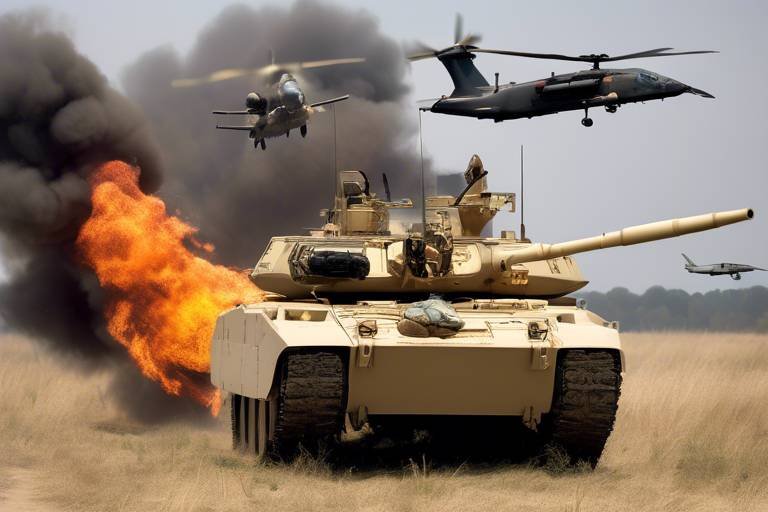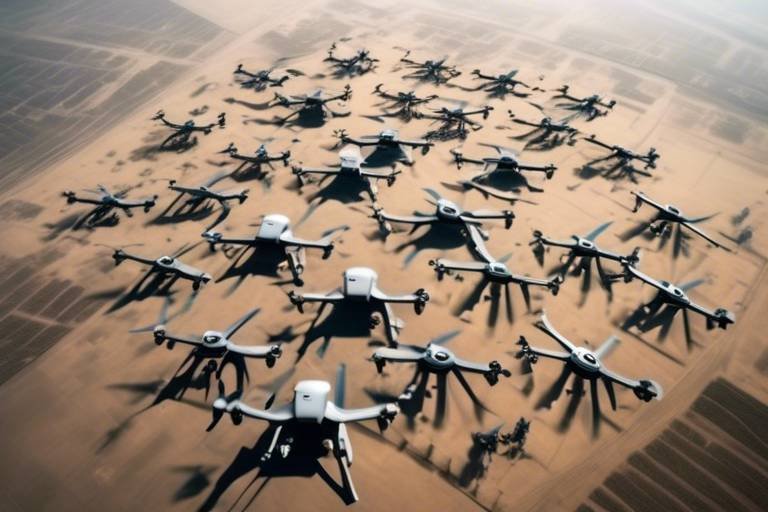The Importance of Modular Weapon Systems in Military Flexibility
In today's rapidly evolving battlefield, the need for adaptability and efficiency has never been more critical. This is where modular weapon systems shine, providing militaries around the world with the flexibility to respond to diverse operational requirements. Imagine a soldier equipped with a weapon that can be reconfigured in minutes to suit different combat scenarios – that’s the power of modularity. These systems allow for the integration of various components, making it easier to switch out parts depending on the mission, whether it’s urban warfare, counterinsurgency, or conventional combat.
Modular weapon systems are not just about having a versatile tool; they represent a fundamental shift in how military forces can operate. By enabling rapid reconfiguration, these systems can be tailored to meet specific mission objectives, which enhances strategic effectiveness and operational readiness. For instance, a single platform can be adapted to carry different types of munitions or equipment, allowing units to maintain a high level of preparedness without the need for extensive logistical support. This adaptability is crucial when considering the unpredictable nature of modern warfare.
Furthermore, the implementation of modular weapon systems can lead to significant cost savings. As we delve deeper into the advantages of these systems, we will uncover how they streamline processes, reduce maintenance costs, and improve training efficiency. The financial implications alone are compelling enough to warrant a closer look at how militaries can leverage these systems to enhance overall effectiveness.
As we explore the various facets of modular weapon systems, it becomes clear that their importance transcends mere functionality. They embody a strategic approach to military readiness that aligns with the complexities of contemporary conflicts. By fostering interoperability among allied forces and adapting to technological advancements, modular systems are set to play a crucial role in shaping the future of military operations.
- What are modular weapon systems? Modular weapon systems are military tools designed with interchangeable components, allowing for quick reconfiguration to meet mission-specific needs.
- How do modular systems enhance operational flexibility? They enable rapid adaptation to various combat scenarios, improving response times and tactical effectiveness.
- What are the cost benefits of using modular weapon systems? They can reduce maintenance and training costs while providing long-term savings through efficient resource allocation.
- Can modular systems be integrated with allied forces? Yes, modular weapon systems promote interoperability, facilitating collaboration among allied nations during joint operations.
[Definition of Modular Weapon Systems]
Understanding what modular weapon systems are is crucial for grasping their impact on modern military operations. At their core, modular weapon systems are designed with interchangeable components, which allow military forces to adapt their equipment for various combat scenarios efficiently. Imagine a toolbox filled with different tools, each serving a unique purpose, yet all designed to fit together seamlessly. This flexibility enables rapid reconfiguration to meet specific mission requirements, providing an edge on the battlefield where conditions can change in the blink of an eye.
The versatility of these systems is not just a theoretical concept; it’s a practical solution to the complexities of modern warfare. For instance, a single platform can be equipped with different weapon configurations, sensors, or communication systems, depending on the mission at hand. This adaptability is essential in today’s fast-paced military environments, where the ability to pivot quickly can mean the difference between success and failure.
Moreover, modular weapon systems can be categorized into several types based on their functionality, such as:
- Firepower Modules: These include different calibers of weapons that can be swapped out based on the operational needs.
- Sensor Packages: Various sensors can be integrated into a single platform, enhancing situational awareness and targeting capabilities.
- Support Equipment: This encompasses communication and logistical modules that can be adjusted to support diverse missions.
The concept of modularity is not just limited to the physical components of weapon systems; it also extends to the software and operational protocols that govern their use. By employing a modular approach, military planners can ensure that their forces remain agile and capable of responding to an array of challenges, from conventional warfare to asymmetric threats.
In summary, modular weapon systems represent a significant evolution in military technology, allowing for enhanced adaptability, operational efficiency, and strategic effectiveness. As we delve deeper into their benefits and real-world applications, it becomes clear that these systems are not just a trend but a fundamental shift in how armed forces prepare for and engage in combat.
[Benefits of Modular Design]
The concept of modular design in weapon systems is not just a trend; it’s a revolutionary approach that brings a multitude of benefits to military operations. Imagine a toolbox where each tool can be swapped out based on the task at hand. This flexibility is precisely what modular systems offer, allowing military forces to adapt quickly to evolving combat scenarios. The advantages are profound, ranging from logistical efficiency to enhanced readiness and cost-effectiveness.
One of the most significant benefits of modular design is its ability to reduce logistical burdens. Traditional weapon systems often require extensive support infrastructure, which can be cumbersome and slow to mobilize. In contrast, modular systems can be tailored to specific missions, allowing for a streamlined supply chain and quicker deployment. This adaptability means that troops can focus on their primary objectives without being weighed down by unnecessary equipment. For instance, a modular rifle system can be configured for different environments, whether it’s urban warfare or open terrain, by simply switching out components.
Furthermore, modular designs contribute to cost-effectiveness. By investing in a single modular platform, militaries can save significantly on procurement costs. Instead of purchasing multiple specialized systems, a single modular system can fulfill various roles. This not only lowers the initial investment but also reduces long-term expenses associated with maintenance and training. A study conducted by the Defense Acquisition University found that modular systems can lead to savings of up to 30% in lifecycle costs compared to traditional systems.
Maintenance is another area where modular design shines. With interchangeable parts, maintaining equipment becomes simpler and more efficient. Imagine having a vehicle that can be repaired by swapping out a malfunctioning component instead of requiring a complete overhaul. This approach not only lowers upkeep expenses but also enhances the lifespan of military assets. A well-maintained modular system can remain operational far longer than its traditional counterparts, providing a better return on investment.
Moreover, training efficiency is greatly enhanced through modular systems. Traditional military training often requires personnel to master multiple, distinct systems, which can be time-consuming and resource-intensive. However, with modular designs, soldiers can quickly become proficient in various configurations. This means that a single training program can cover multiple weapon setups, allowing troops to adapt to different missions without the need for extensive retraining. In fact, many military organizations have reported a reduction in training time by as much as 40% when implementing modular systems.
In summary, the benefits of modular design in weapon systems extend far beyond mere convenience. They encompass significant improvements in operational efficiency, cost savings, and training effectiveness. As military forces continue to face diverse and unpredictable challenges, the ability to adapt swiftly and efficiently is more crucial than ever. Modular systems not only provide the tools for today’s battles but also pave the way for future innovations in military technology.
[Cost-Effectiveness]
When we dive into the financial implications of modular weapon systems, it's like opening a treasure chest of savings and efficiency. Imagine a military that doesn't just throw money at problems but smartly allocates resources where they matter most. Modular systems are designed with this very principle in mind, allowing for significant reductions in costs associated with maintenance, training, and procurement. These systems enable armed forces to operate with greater financial prudence while still maintaining a high level of operational readiness.
One of the standout features of modular weapon systems is their ability to reduce logistical burdens. Traditional military systems often require a slew of specialized parts and equipment, leading to inflated costs and complex supply chains. In contrast, modular systems streamline these processes by utilizing interchangeable components. This means that instead of stocking a vast array of parts for different systems, military units can maintain a smaller inventory of versatile components that can be quickly swapped out as needed. This not only cuts down on storage costs but also simplifies the supply chain, making it easier to keep troops equipped and ready for action.
Moreover, the cost-effectiveness of modular weapon systems extends into the realm of training. Think about it: when personnel need to learn how to operate multiple, distinct weapon systems, the training time and resources can skyrocket. However, with modular designs, soldiers can become proficient in various configurations in a fraction of the time. This efficiency translates into lower training costs and allows military forces to allocate more resources to operational readiness instead of prolonged training sessions. In essence, modularity acts as a force multiplier, maximizing the effectiveness of every dollar spent.
To illustrate the financial benefits further, consider the following table, which outlines the cost savings associated with modular systems compared to traditional weapon systems:
| Cost Factor | Traditional Systems | Modular Systems |
|---|---|---|
| Initial Procurement Costs | High | Moderate |
| Maintenance Costs | High | Low |
| Training Costs | High | Low |
| Logistical Complexity | High | Low |
As we can see from the table, the transition to modular weapon systems can significantly lower both initial and ongoing costs. This financial efficiency is crucial, especially in an era where defense budgets are constantly under scrutiny. By adopting a modular approach, military forces can not only save money but also reinvest those savings into other critical areas, such as research and development or enhancing soldier welfare.
In conclusion, the cost-effectiveness of modular weapon systems is not just a nice-to-have feature; it is a game-changer for military operations. By reducing maintenance and training costs while simplifying logistics, these systems enable armed forces to operate more efficiently and effectively. As we move forward, embracing modularity may very well be the key to maintaining a competitive edge in modern warfare.
[Reduced Maintenance Costs]
One of the standout advantages of modular weapon systems is their ability to significantly reduce maintenance costs. Imagine a world where military equipment can be swiftly repaired and upgraded without the need for extensive downtime or complex procedures. This is precisely what modularity brings to the table. By utilizing interchangeable components, maintenance personnel can easily swap out defective parts or upgrade systems with new technology, all without needing to overhaul the entire weapon system. This not only saves time but also cuts down on labor costs associated with lengthy repair processes.
Moreover, the simplicity of modular systems means that training for maintenance staff becomes more straightforward. Instead of mastering a myriad of complex systems, technicians can focus on a few key components that apply across various platforms. This streamlined approach leads to quicker troubleshooting and repairs, ensuring that military units spend less time sidelined and more time operational. For instance, consider a scenario where a specific part of a weapon system fails in the field. With modular design, the team can quickly replace that part with a readily available spare, allowing them to maintain their operational readiness.
To illustrate the cost savings associated with reduced maintenance, let's take a look at a hypothetical comparison of traditional weapon systems versus modular weapon systems:
| Aspect | Traditional Weapon Systems | Modular Weapon Systems |
|---|---|---|
| Initial Procurement Costs | Higher due to specialized parts | Lower, as components can be reused |
| Maintenance Time | Longer due to complexity | Shorter, thanks to easy swaps |
| Training Duration for Technicians | Longer, requires specialized knowledge | Shorter, focused on modular components |
| Overall Lifecycle Cost | Higher due to frequent repairs | Lower, with reduced repair frequency |
In summary, the modular approach not only enhances the efficiency of maintenance operations but also leads to substantial cost savings over the lifecycle of the weapon systems. By minimizing the complexity of repairs and maximizing the interchangeability of parts, military forces can ensure that their equipment remains operational and effective without the burden of excessive maintenance expenses.
[Training Efficiency]
When it comes to military operations, the speed and effectiveness of training can make all the difference. Modular weapon systems are a game changer in this regard, as they allow personnel to master a variety of configurations without the need for extensive retraining. Imagine a soldier who can transition from operating a standard rifle to a grenade launcher with minimal downtime. This flexibility not only enhances individual skill sets but also contributes to a more agile and responsive military force.
One of the key advantages of modular systems is that they enable a streamlined training process. Instead of training on multiple distinct systems, soldiers can focus on one core platform that can be adapted for different missions. This efficiency means that training time is significantly reduced, allowing military units to maintain a high level of readiness without sacrificing depth of knowledge. For instance, a single training session can cover multiple weapon configurations, ensuring that troops are well-prepared for any scenario they might encounter.
Moreover, the modular design simplifies the instructional process. Instructors can utilize a common framework to teach various configurations, which not only saves time but also enhances the learning experience. With the ability to switch components and features on the fly, trainees can engage in realistic simulations that mirror actual combat conditions. This hands-on approach fosters a deeper understanding of the systems being used, translating to improved performance in the field.
Additionally, the adaptability of modular systems allows for tailored training programs that can address specific mission requirements. For example, if a unit is preparing for a particular operation that requires unique configurations, training can be adjusted accordingly. This level of customization is invaluable, as it ensures that soldiers are not just familiar with their equipment but are also prepared for the specific challenges they will face.
In summary, the efficiency of training with modular weapon systems cannot be overstated. By reducing the time and resources needed for training while enhancing the soldiers' ability to adapt, these systems play a crucial role in maintaining operational readiness. As military forces continue to evolve, the importance of effective training methods will only grow, making modular systems an essential component of modern military strategy.
- What are modular weapon systems? Modular weapon systems are firearms designed with interchangeable components that allow for quick reconfiguration to suit different missions.
- How do modular systems improve training efficiency? They simplify the training process by allowing personnel to focus on one core platform while adapting to various configurations, reducing training time and enhancing readiness.
- Can modular systems be customized for specific missions? Yes, modular systems can be tailored to meet the unique requirements of different operations, allowing for targeted training and preparation.
- What are the long-term benefits of using modular weapon systems? Long-term benefits include cost savings, reduced logistical burdens, and enhanced operational flexibility, all of which contribute to overall military effectiveness.
[Enhanced Operational Flexibility]
The modern battlefield is a dynamic environment where adaptability can mean the difference between victory and defeat. This is where modular weapon systems shine, offering unparalleled operational flexibility that traditional systems simply cannot match. Imagine being in a situation where the enemy is employing tactics you didn’t anticipate. With modular systems, military forces can swiftly reconfigure their weaponry to respond to these unexpected changes, ensuring they remain one step ahead. This capability is akin to having a Swiss Army knife in combat—versatile tools at your disposal that can be adapted for various tasks as the situation demands.
One of the most significant advantages of modular weapon systems is their ability to be reconfigured rapidly. This means that a single platform can be transformed to suit different mission profiles, whether that’s switching from a ground assault role to a reconnaissance function. For instance, a modular vehicle equipped with different weapon modules can transition from engaging enemy forces to performing surveillance missions without the need for extensive downtime. This flexibility not only improves operational readiness but also enhances the overall effectiveness of military operations.
Moreover, modularity fosters a culture of innovation within the military. As new technologies emerge, such as advanced sensors or next-generation munitions, these can be integrated into existing systems without the need for a complete overhaul. This is particularly important in an era where technological advancements happen at lightning speed. By allowing for easy upgrades, modular systems ensure that military forces can leverage the latest innovations to maintain a tactical edge. In this way, they become not just tools of war but platforms for continuous improvement and adaptation.
However, it's essential to recognize that enhanced operational flexibility does not come without its challenges. The integration of diverse components can lead to potential compatibility issues, which necessitates rigorous testing and evaluation. Furthermore, as military forces strive to maintain flexibility, there is a constant need for training to ensure personnel are proficient in operating these modular systems across their various configurations. This is where the synergy between modularity and training becomes crucial—training programs must evolve alongside the systems to maximize their potential.
In conclusion, the operational flexibility offered by modular weapon systems is a game-changer in modern warfare. They provide military forces with the ability to adapt quickly to changing scenarios, integrate new technologies seamlessly, and maintain a state of readiness that is vital for success on the battlefield. As we look to the future, the integration of these systems will likely become even more pronounced, driving further innovations and adaptations in military strategy.
[Real-World Applications]
The implementation of modular weapon systems in military operations has transformed how armed forces engage in modern warfare. These systems have proven their worth in various real-world scenarios, showcasing their adaptability and effectiveness. One notable example is the use of modular systems in recent conflicts, where rapid reconfiguration of weaponry allowed for tailored responses to unique battlefield challenges.
For instance, during the Syrian Civil War, modular weapon systems were employed by various factions, allowing them to quickly switch between offensive and defensive configurations. This adaptability was crucial in a conflict characterized by rapidly changing alliances and strategies. By utilizing interchangeable components, forces could effectively respond to different threats without the need for extensive logistical support or lengthy downtimes for equipment modification.
Similarly, in the ongoing counter-terrorism operations in the Middle East, modular weapon systems have enabled coalition forces to collaborate more effectively. These systems promote interoperability among allied nations, ensuring that different military branches can work together seamlessly. For example, U.S. forces have integrated modular designs into their operations, allowing them to share equipment and resources with partner nations, thus enhancing joint operational capabilities.
Another compelling case study is the use of modular systems in the U.S. Army’s Modular Handgun System. This program allows soldiers to customize their sidearms based on mission requirements. The ability to switch components such as grips, sights, and calibers not only increases the weapon's versatility but also boosts the confidence of soldiers in various combat situations. The Army's decision to adopt this modular approach reflects a broader trend towards embracing flexibility in military operations.
Moreover, the lessons learned from these applications highlight the importance of training efficiency in utilizing modular systems effectively. Military training programs are increasingly focused on teaching personnel how to operate multiple configurations of their weapon systems. This not only enhances readiness but also fosters a culture of adaptability within the ranks, preparing soldiers for the unpredictable nature of modern warfare.
In conclusion, the real-world applications of modular weapon systems underscore their significance in contemporary military strategy. By enabling rapid reconfiguration and promoting interoperability, these systems are not just tools of war; they are essential components that enhance the overall effectiveness and efficiency of military operations.
- What are modular weapon systems? Modular weapon systems are designed with interchangeable components that allow for rapid reconfiguration to meet specific mission requirements.
- How do modular systems improve military training? They streamline training processes, enabling personnel to quickly become proficient in multiple configurations.
- Can modular weapon systems be used by allied forces? Yes, they facilitate interoperability among allied nations, enhancing collaboration during joint operations.
- What are some challenges associated with modular systems? Challenges may include integration issues and the need for continuous innovation to keep pace with technological advancements.
[Case Study: Modern Conflicts]
In recent years, the battlefield has transformed dramatically, with modular weapon systems emerging as pivotal tools in modern conflicts. These systems have proven to be not just effective, but essential for adapting to the dynamic nature of warfare. One striking example can be seen in the operations conducted by various military forces in the Middle East, where modular systems have been deployed to address a range of combat scenarios. These adaptable platforms have allowed troops to switch configurations on-the-fly, tailoring their weapons to meet specific threats, whether they be urban insurgencies or conventional warfare.
Take the case of the U.S. military's Modular Handgun System (MHS). This revolutionary approach to sidearms has enabled soldiers to customize their weapons for different missions. With interchangeable parts, troops can modify their handguns with various grips, sights, and calibers. This flexibility not only enhances individual soldier effectiveness but also ensures that units can quickly adapt to changing mission profiles. For instance, during a recent operation in a densely populated area, soldiers were able to switch their handgun configurations to accommodate suppressors, significantly reducing noise and minimizing civilian casualties.
Another noteworthy example is the use of modular weapon systems by NATO forces during joint exercises. These exercises have revealed how interoperability can be greatly enhanced through modular designs. Soldiers from different nations have trained together using compatible systems, allowing for seamless integration of equipment and tactics. For example, the modular design of the FN SCAR rifle has allowed various NATO countries to utilize the same platform while maintaining their national specifications. This not only simplifies logistics but also enhances operational efficiency during multinational missions.
Moreover, the ongoing conflict in Ukraine has showcased the importance of modularity in adapting to unexpected challenges. Ukrainian forces have effectively employed modular artillery systems, which can be quickly reconfigured for different types of munitions. This capability has proven crucial in responding to the fluid nature of the battlefield, where the type of engagement can shift from long-range bombardments to close-quarters combat in a matter of hours. The ability to swiftly adapt artillery systems to meet the immediate needs of the battlefield has provided a significant tactical advantage.
In summary, the real-world applications of modular weapon systems in modern conflicts highlight their versatility and strategic importance. By allowing rapid reconfiguration and fostering interoperability among allied forces, these systems have become indispensable in contemporary military operations. As we continue to analyze these case studies, it is clear that embracing modularity not only enhances military effectiveness but also prepares forces to face the unpredictable challenges of future warfare.
- What are modular weapon systems? Modular weapon systems are adaptable platforms that allow for interchangeable components, enabling rapid reconfiguration to meet various mission requirements.
- How do modular systems enhance military training? They streamline training processes, allowing personnel to quickly become proficient in multiple configurations, thereby improving overall readiness.
- Can modular systems be used by allied forces? Yes, modular weapon systems promote interoperability among allied nations, enhancing joint operations and strategic alliances.
- What are the challenges of implementing modular weapon systems? Challenges include integration issues, the need for continuous innovation, and potential logistical complexities.
[Interoperability with Allied Forces]
In today's complex battlefield, the ability to work seamlessly with allied forces is more crucial than ever. Modular weapon systems play a pivotal role in enhancing this interoperability. By allowing different military branches and nations to utilize compatible systems, these modular designs foster a collaborative environment that is essential for successful joint operations. Imagine a scenario where different countries' forces can share equipment and resources without the hassle of extensive modifications or training. This is where modularity shines, as it enables a level of flexibility that traditional systems simply cannot match.
One of the standout features of modular weapon systems is their ability to be configured in various ways to meet the specific needs of different forces. For example, a particular weapon platform can be adapted to use different calibers or types of munitions, depending on what the mission requires. This adaptability not only enhances the effectiveness of military operations but also ensures that allied forces can communicate and collaborate more efficiently. When every unit can modify its equipment to fit the mission, it creates a unified front that is better prepared to tackle challenges.
Moreover, the integration of modular systems can significantly reduce the time and resources needed for joint training exercises. When allied forces are equipped with similar systems, the learning curve is drastically shortened. Troops can train together using the same platforms, which promotes a deeper understanding of each other's capabilities and strategies. This shared knowledge is invaluable in high-stakes situations where quick decision-making and coordination can mean the difference between success and failure.
To illustrate this point, consider the following table that outlines the benefits of modular weapon systems in promoting interoperability among allied forces:
| Benefit | Description |
|---|---|
| Shared Training Resources | Allied forces can train on the same systems, reducing training time and improving joint operational readiness. |
| Cost Efficiency | Shared systems lead to lower procurement costs and maintenance expenses across the board. |
| Rapid Adaptation | Forces can quickly adapt to changing missions and environments, ensuring they remain effective in diverse scenarios. |
| Enhanced Communication | Modular systems facilitate better communication and coordination during joint operations, leading to more effective strategies. |
In conclusion, the interoperability of modular weapon systems not only enhances military effectiveness but also strengthens the bonds between allied nations. These systems pave the way for a more unified approach to modern warfare, where cooperation and flexibility are paramount. As military forces continue to evolve, embracing modularity will be essential for maintaining a strategic edge in an increasingly interconnected world.
- What are modular weapon systems? Modular weapon systems are military platforms designed with interchangeable components that can be quickly reconfigured for different missions.
- How do modular systems enhance interoperability? By allowing different military branches and allied forces to use compatible systems, modular designs facilitate collaboration and joint operations.
- What are the cost benefits of modular weapon systems? Modular systems can significantly reduce costs associated with maintenance, training, and procurement through shared resources and streamlined processes.
- Can modular systems adapt to new technologies? Yes, modular systems are designed to accommodate technological advancements, ensuring they remain relevant and effective in future military engagements.
[Future Trends in Modular Systems]
The landscape of military technology is constantly evolving, and modular weapon systems are at the forefront of this transformation. As we look towards the future, several trends are emerging that promise to redefine how these systems are designed, implemented, and utilized in combat scenarios. One of the most significant trends is the integration of artificial intelligence (AI) and robotics. These technologies are not just add-ons; they are set to revolutionize the modular approach by enabling real-time data processing and autonomous decision-making on the battlefield.
Imagine a scenario where a modular weapon system can assess its environment, determine the best configuration for an upcoming mission, and even execute those changes autonomously. This level of adaptability could provide a crucial edge in combat situations, allowing military forces to respond to threats with unprecedented speed and precision. Furthermore, the incorporation of AI can enhance predictive maintenance, ensuring that equipment is always in optimal condition and reducing the risk of failure during critical operations.
Another trend is the increasing emphasis on interoperability among allied forces. As military operations become more collaborative, the need for systems that can seamlessly integrate with those of partner nations is paramount. Modular weapon systems are uniquely positioned to meet this demand, as their interchangeable components can be designed to accommodate the specifications of various militaries. This not only enhances joint operational capabilities but also fosters stronger strategic alliances.
Moreover, the rise of 3D printing technology is poised to impact the future of modular systems significantly. Imagine being able to manufacture replacement parts or even entire components on-site, tailored to specific mission requirements. This capability could drastically reduce logistical challenges and improve supply chain efficiency. With 3D printing, military units can maintain a higher level of operational readiness, as they can quickly adapt their equipment to meet evolving threats.
However, as we embrace these advancements, it is essential to acknowledge the challenges that come with them. The integration of new technologies into existing systems can pose significant hurdles. For example, ensuring that all components work together seamlessly requires continuous innovation and rigorous testing. Furthermore, as modular systems become more complex, the need for highly trained personnel who can operate and maintain these systems will be critical.
In summary, the future of modular weapon systems is bright, filled with opportunities for enhanced adaptability, efficiency, and collaboration. As military forces around the world continue to invest in these technologies, we can expect to see a transformation in how they approach warfare, ultimately leading to more effective and strategic operations.
- What are modular weapon systems?
Modular weapon systems are designed with interchangeable components, allowing for rapid reconfiguration to meet specific mission requirements. - How do modular systems enhance military flexibility?
They allow forces to adapt quickly to changing battlefield conditions and can be tailored for various missions. - What role does AI play in the future of modular systems?
AI can enable real-time data processing, autonomous decision-making, and predictive maintenance, enhancing operational efficiency. - Will 3D printing impact modular weapon systems?
Yes, it allows for on-site manufacturing of parts, improving logistical efficiency and operational readiness. - What challenges do modular systems face?
Integration issues and the need for continuous innovation are significant challenges that must be addressed.
[Technological Advancements]
The landscape of military operations is undergoing a seismic shift, largely driven by technological advancements that promise to redefine the capabilities of modular weapon systems. As we stand on the brink of a new era, innovations in artificial intelligence (AI), robotics, and data analytics are set to enhance the flexibility and effectiveness of these systems in unprecedented ways. Imagine a battlefield where weapons can not only be reconfigured on-the-fly but can also make autonomous decisions based on real-time data; this is not just a futuristic dream but an impending reality.
One of the most exciting aspects of these advancements is the integration of AI into modular systems. AI algorithms can analyze vast amounts of battlefield data, enabling commanders to make informed decisions quickly. For instance, AI can assess threats, optimize weapon configurations, and even predict enemy movements, thereby enhancing situational awareness. This capability allows military personnel to adapt their strategies in real-time, ensuring that they remain one step ahead of their adversaries.
Moreover, robotics is playing a pivotal role in the evolution of modular weapon systems. Unmanned systems, such as drones and robotic vehicles, can be equipped with modular components that allow for easy upgrades and modifications. This adaptability means that a single platform can serve multiple roles, from surveillance to direct combat, depending on the mission requirements. Such versatility not only maximizes the utility of military resources but also minimizes the need for extensive retraining of personnel, as they can operate various configurations of the same system.
To illustrate the impact of these technological advancements, consider the following table that outlines some of the key innovations and their implications for modular weapon systems:
| Technology | Implications |
|---|---|
| Artificial Intelligence | Real-time data analysis, threat assessment, autonomous decision-making |
| Robotics | Enhanced operational flexibility, reduced need for retraining, multi-role capabilities |
| Data Analytics | Improved logistics, predictive maintenance, optimized resource allocation |
In addition to these innovations, the rise of data analytics is transforming how military forces manage their resources. With sophisticated data analysis tools, military planners can forecast maintenance needs, streamline supply chains, and ensure that troops have access to the right equipment at the right time. This proactive approach not only reduces downtime but also enhances overall operational readiness.
However, as we embrace these advancements, we must also be mindful of the challenges they present. The integration of new technologies into existing systems requires careful planning and execution. There is a risk of over-reliance on automated systems, which could lead to vulnerabilities if not managed properly. Additionally, the rapid pace of technological change necessitates continuous training and adaptation to keep personnel up-to-date with the latest innovations.
In conclusion, the future of modular weapon systems is undoubtedly intertwined with technological advancements. As AI, robotics, and data analytics continue to evolve, they will reshape the battlefield landscape, enhancing military adaptability and effectiveness. The potential for these technologies to revolutionize how military operations are conducted is immense, but it also calls for a balanced approach to ensure that the human element remains at the forefront of decision-making.
- What are modular weapon systems? Modular weapon systems are designed with interchangeable components that allow for quick reconfiguration to meet specific mission needs.
- How does AI enhance modular weapon systems? AI enhances these systems by providing real-time data analysis, improving situational awareness, and enabling autonomous decision-making.
- What role do robotics play in modern military operations? Robotics increase operational flexibility by allowing for multi-role capabilities and reducing the need for extensive retraining of personnel.
- What are the challenges associated with implementing new technologies? Challenges include integration issues, over-reliance on automated systems, and the need for continuous training to keep personnel updated.
[Challenges and Considerations]
While the advantages of modular weapon systems are significant, it is essential to recognize the challenges and considerations that come with their implementation. One of the primary challenges is the integration of various components. As these systems are designed to be adaptable, ensuring that all interchangeable parts function seamlessly together can be a daunting task. This requires extensive testing and validation to confirm that each module operates effectively within the broader system, which can be time-consuming and costly.
Moreover, the rapid pace of technological advancement poses another challenge. Military forces must continuously innovate and upgrade their modular systems to keep pace with emerging threats and technological developments. This need for constant evolution can strain resources and complicate logistics, as outdated components may need to be phased out or retrofitted to remain compatible with newer technologies.
Additionally, there is the issue of training personnel to effectively use these modular systems. While modularity can simplify training by allowing soldiers to become proficient in multiple configurations, it also requires a robust training program to ensure that all personnel are adequately prepared for the diverse scenarios they may encounter. This can lead to increased training costs and time commitments, which can detract from operational readiness.
Furthermore, interoperability with allied forces can present its own set of challenges. While modular systems are designed to facilitate collaboration, differences in standards, protocols, and equipment among allied nations can complicate joint operations. Ensuring that all forces can effectively communicate and operate together using modular systems requires careful planning and coordination.
Lastly, organizations must consider the logistical implications of maintaining a modular arsenal. While modular systems can reduce the number of spare parts needed, they also require a comprehensive logistical framework to manage the various components and ensure they are available when needed. This can create additional layers of complexity in supply chain management.
In summary, while the promise of modular weapon systems is enticing, military leaders must navigate a landscape filled with potential pitfalls. Addressing these challenges head-on is crucial for maximizing the benefits of modularity while minimizing the risks associated with their implementation.
- What are modular weapon systems? Modular weapon systems are adaptable military platforms that feature interchangeable components, allowing for quick reconfiguration to meet specific mission requirements.
- What are the main benefits of modular weapon systems? The main benefits include cost-effectiveness, reduced maintenance costs, enhanced operational flexibility, and streamlined training processes.
- What challenges do military forces face with modular systems? Challenges include integration issues, the need for ongoing training, interoperability with allied forces, and logistical complexities.
- How do technological advancements impact modular weapon systems? Emerging technologies like AI and robotics are set to enhance the capabilities and effectiveness of modular systems, but they also require continuous adaptation and innovation.
Frequently Asked Questions
- What are modular weapon systems?
Modular weapon systems are innovative military technologies that consist of interchangeable components. This design allows for quick reconfiguration to adapt to various combat scenarios, enhancing versatility and operational efficiency.
- What are the benefits of using modular designs in the military?
Modular designs offer a host of advantages, including reduced logistical burdens, cost-effectiveness, and improved operational readiness. By allowing for easy upgrades and repairs, these systems help military forces maintain peak performance with less hassle.
- How do modular weapon systems contribute to cost savings?
These systems can significantly lower costs related to maintenance, training, and procurement. With interchangeable parts, the need for extensive inventory management diminishes, leading to long-term savings and better allocation of resources.
- What impact do modular systems have on military training?
Modular systems streamline training processes, enabling personnel to quickly become proficient in multiple configurations. This adaptability reduces training time and enhances the overall skill set of military personnel, making them more effective in the field.
- Can you provide examples of modular weapon systems in real-world applications?
Certainly! Recent military engagements have showcased the effectiveness of modular weapon systems. For instance, forces have utilized these systems to adapt quickly to changing battlefield conditions, demonstrating their practical value in modern warfare.
- How do modular systems facilitate interoperability with allied forces?
Modular weapon systems promote interoperability by allowing different nations to use compatible equipment. This compatibility enhances joint operations, making it easier for allied forces to collaborate effectively during missions.
- What future trends can we expect in modular weapon systems?
The future of modular weapon systems is likely to be shaped by advancements in technology, such as artificial intelligence and robotics. These innovations will enhance the capabilities of modular systems, leading to more efficient and effective military operations.
- What challenges do modular weapon systems face?
While modular systems offer many benefits, they also face challenges like integration issues and the need for continuous innovation. Staying relevant in a rapidly evolving technological landscape is crucial for maintaining their effectiveness.

